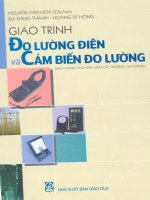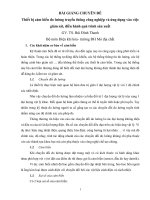Flow measurement Cảm biến lưu lượng
Bạn đang xem bản rút gọn của tài liệu. Xem và tải ngay bản đầy đủ của tài liệu tại đây (3.93 MB, 66 trang )
Products
Solutions
Flow Measurement
Slide 1 / 76
13 October 2015
GBO
Services
10/13/2015
Learning Objectives
The participant knows…
• … coriolis, electromagnetic, vortex and thermal flow measurement
principle
• …application and installation limits
The participant understands…
• …each measurement technology has different limitation
• … application
li ti and
d process conditions
diti
and
d iinstallations
t ll ti
are very
important
Slide 2 / 76
13 October 2015
GBO
10/13/2015
The first step to find the solution
• The first step in finding a solution for a flow metering point is finding the best suitable measuring
technology
• The selection is based on the requirements of the measuring point e.g.:
Expecte
d
accurac
y
Require
d tturndown
Slide 3 / 76
13 October 2015
Accepta
ble
pressur
e loss
Mass
flow,
di
direct
t or
calculate
d
Installati
on
situation
E
Etc.
GBO
10/13/2015
Influences on the selection of the measuring system
Liquid /
Gas
Mass
or
Volume
Viscosit
y
Conduc
C
d
tivity
Abrasion
Pressur
e
Corrosio
n
Density
Price
Best fit
measuring
system
Accepte
d
pressure
loss
Temp.
Pipe
inlet
Pipe
Homog
eneity
Slide 4 / 76
13 October 2015
Disturb
ances
GBO
Flow
profile
Turn
down
10/13/2015
Rough classification of applications
• Conductive liquids
>80% of all liquids are conductive (Drinking- and waste water,
beverages acids
beverages,
acids, alkalines
alkalines, etc
etc.))
• Non conductive liquids
Oils, hydro carbons, liquefied gases, demineralized water
• Gas
Air, nitrogen, natural gas, biogas, etc.
• Steam
Saturated and superheated steam
• Special applications
Abrasive slurries, custody transfer, measurement from
outside, bidirectional, etc.
Slide 5 / 76
13 October 2015
GBO
10/13/2015
Flow technologies overview
Slide 6 / 76
13 October 2015
GBO
LU/MSA
10/13/2015
Application Range
Slide 7 / 76
13 October 2015
GBO
10/13/2015
Application Range
1000
Temp.
[°C]
Differential Pressure
400
350
Vortex
Coriolis
200
Magnetic Inductive
pressure
[bar]
Ultrasonic
Thermal
40
0
Slide 8 / 76
13 October 2015
GBO
160
250
400
420
Products
Solutions
Flow Measurement – Coriolis Measurement
Slide 9 / 76
13 October 2015
GBO
Services
10/13/2015
The Coriolis Measuring Principle
Inventor of the measuring principle
of the same name.
Caspard Gustave de Coriolis
Slide 10 / 76
13 October 2015
GBO
10/13/2015
Basics of Mass Measurement - Why Measure Mass?
•Temperature
•Volume 1 ≠ Volume 2
•Mass
M
1 = Mass
M
2
Slide 11 / 76
Mass 1
Mass 2
V l
Volume
1
Volume 2
13 October 2015
GBO
10/13/2015
Basics of Mass Measurement
•ω
•Fc
= Angular velocity
= Coriolis force
•Δ
Δϕ = Phase shift
•A,B = Sensors
•y
= Amplitude
•t
= Time
Δϕ ~ Fc ~ m
Slide 12 / 76
13 October 2015
GBO
10/13/2015
Basics of Mass Measurement - Density Measurement
mt
c
1
⋅
2π mfl + mt
mfl = V ⋅ ρfl
fR =
fR = Resonant frequency
mt = Tube
T b mass
mfl = Fluid mass
ρfl = Fluid density
c = Constant
fR
Slide 13 / 76
mfl
13 October 2015
GBO
fR = ƒ(ρfl)
10/13/2015
Basics of Mass Measurement- Measuring System
• Δϕ = Phase shift
•m
= Mass flow
•Ω
= RTD resistance
• fR
= Resonant frequency
•ρ
= Density
•T
= Temperature
T
t
Δϕ ~ m
Slide 14 / 76
13 October 2015
GBO
fR
~ ρ
Ω
~ T
10/13/2015
Coriolis flow meter advantages
• Universal measuring principle for liquids and gases
• Simultaneous and direct measurement of mass
flow density
flow,
density, temperature and viscosity
(multivariable sensors)
• Measuring principle is independent of the physical
fluid properties
p p
• Very high measuring accuracy
– typically ±0.1% o.r.
– optionally ±0.05% o.r.
• Not affected by flow profile
• No inlet/outlet runs necessary
Slide 15 / 76
13 October 2015
GBO
10/13/2015
Coriolis flow meter disadvantages:
• Relatively high initial investment.
• Outlay for installation can be considerable, depending on the design
and manufacturer
manufacturer.
• Limited temperature range: typically –50 to +350 °C (–60 to +660 °F).
• Restricted usability if the gas content of the fluid is high and in the
case of multi-phase fluids.
• Larger
L
sizes
i
are h
heavy iin some d
designs.
i
Slide 16 / 76
13 October 2015
GBO
Products
Solutions
Services
Flow Measurement – Electromagnetic Measurement
Slide 17 / 76
13 October 2015
GBO
10/13/2015
The Electromagnetic Measuring Principle
Michael Faraday
Slide 18 / 76
13 October 2015
GBO
Flow
Basics of Electromagnetic Measurement
A voltage is induced in an
electric conductor is moved
through a magnetic field.
L
B
B
-
+
v
Faraday‘s
Faraday
s Law
0
+
Ue
Slide 19 / 76
13 October 2015
GBO
Ue = B × L× v
B = Strength of Magnetic Field
L = Length of Conductor
v = Velocity of Conductor
OHNE DETAILS
Flow
Basics of Electromagnetic Measurement
Ue = B × L× v
B = Strength of Magnetic Field
L = Length of Conductor
v = Velocity of Conductor
U~v
U = Induced voltage
v = Flow velocity
Q=vxA
U=Approx. 300 μV per m/s
Slide 20 / 76
13 October 2015
GBO
Q = Volume flow
v = Flow velocity
A = Pipe area
Flow
Basics of Electromagnetic -Various EMF Design
Slide 21 / 76
13 October 2015
GBO
Flow
Basics of Electromagnetic - Ranges of Conductivity in Liqui
Oil,
Hydrocarbons
Ultra pure water
0.05 µS/cm
Water:
1 µS/cm
Min. Conductivity
for EMF’s
10 µS/cm
Mi Conductivity
Min.
C d ti it
for EMF’s in water
Pure water
Industrial water
100 µS/cm
Potable water
1 mS/cm
Food:
Beer
Milk
Orange juice
Apple juice
Tomato juice
Process:
Phosphoric acid
Sulphuric acid
Hydrochloric acid
Caustic soda
10 mS/cm
100 mS/cm
1000 mS/cm
Slide 22 / 76
13 October 2015
GBO
Flow
Basics of Electromagnetic - Empty Pipe Detection (EPD)
EPD electrode
Measuring
electrode
l t d
Measuring
electrode
l t d
Slide 23 / 76
13 October 2015
GBO
Flow
Basics of Electromagnetic - Reference Electrode
EPD electrode
Measuring
electrode
Measuring
electrode
Reference
electrode
Slide 24 / 76
13 October 2015
GBO
10/13/2015
Basics of Electromagnetic - Electrode Cleaning Circuit
Function settings:
• Cleaning time
• Relaxation time
• Cycle time
Measuring
electrode
Measuring
electrode
U
Reference
electrode
l t d
Slide 25 / 76
13 October 2015
GBO
ECC inhibits the build-up
build up
of (conductive) coating









